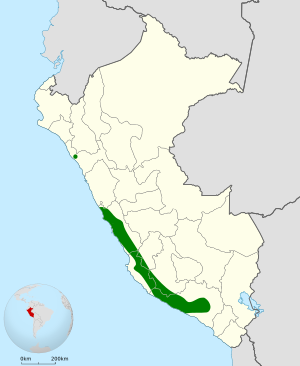Cactus canastero facts for kids
Quick facts for kids Cactus canastero |
|
|---|---|
 |
|
| Conservation status | |
| Scientific classification | |
| Genus: |
Pseudasthenes
|
| Species: |
cactorum
|
 |
|
The cactus canastero (Pseudasthenes cactorum) is a small, interesting bird that lives only in Peru. It's part of the Furnariidae bird family, which includes many birds known for building unique nests. This special bird gets its name because it often lives among cactus plants.
Contents
Where Does the Cactus Canastero Live?
The cactus canastero makes its home in the high mountains of Peru. It prefers areas with lots of shrubs and sometimes cacti. These places are often called "subtropical" or "tropical high-altitude shrublands." Imagine dry, sunny hillsides with tough bushes and spiky plants. This bird is perfectly adapted to live in these challenging environments.
A Bird Found Only in Peru
When we say the cactus canastero is "endemic" to Peru, it means you won't find this bird living naturally anywhere else in the world! It's a truly unique species to that country. This makes it very special and important for Peru's wildlife.
What Does It Look Like?
The cactus canastero is a small bird, usually about 15 centimeters (6 inches) long. It has a dull brown color on its back and lighter, sometimes streaky, feathers on its belly. Its tail is often long and pointed. These colors help it blend in with the dry, rocky places where it lives.
What Does It Eat?
Like many small birds, the cactus canastero mainly eats insects. It forages among the branches of shrubs and cacti, looking for spiders, beetles, and other small creatures. Its sharp beak helps it pick out tiny insects from cracks and leaves.
How Was It Discovered?
This bird was first described by a scientist named Hans-Wilhelm Koepcke in 1959. Scientists study birds like the cactus canastero to learn more about their lives. They also want to understand how to protect them and their homes.
Why Is It Important?
Every animal plays a role in its environment. The cactus canastero helps control insect populations. It also adds to the amazing variety of life found in Peru. Protecting this bird means protecting its unique habitat and the other creatures that live there.


